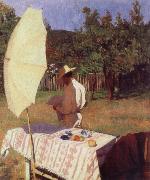
Oil On
Canvas, Real Flavor of Old Masters
|
Karoly Ferenczy
|
|||
|
|
|||
| 1863-1917 Karoly Ferenczy Locations was a Hungarian Impressionist painter. He was one of the leading artists of the Nagybanya school of painting. He studied law and economics. He began to deal with painting at the Academie Julian in Paris. In 1889, he moved back to Hungary, to the town of Szentendre. Between 1893 and 1896 he lived in Munich with his family: There he joined the circle of Simon Hollosy: with whom he moved to Nagybanya in 1896 and became the leading painter of the artist colony. After 1906 he moved to Budapest and became the professor of the College of Fine Arts. His wife Olga Fialka and their children, the painter Valer Ferenczy (1885-1954), the tapestry weaver Noemi Ferenczy (1890-1957) and the sculptor Beni Ferenczy (1890- 1967) were famous representatives of Hungarian art. | |||
|
|
|||
|
|
October Karoly Ferenczy1.jpg Painting ID:: 1207 Visit European Gallery |
1903 Hungarian National Gallery | |
Height Width |
INS/CM |
||
|
X |
|
||
|
|
|||
|
Carl Larsson
|
|||
|
|
|||
| Swedish Realist Painter, 1853-1919 Swedish painter, illustrator and printmaker. He came from a poor family and studied (1866-76) at the Konstakademi in Stockholm, supporting himself throughout this period. From 1871 to 1878 he contributed illustrations to the comic journal Kaspar and the Ny illustrerad tidning. From 1875, for several decades, he was a prolific book illustrator, his most renowned work in this field being his drawings for Föltskärns beröttelser ('The Barber-surgeon's tales'; pubd 1883-4) by Zacharius Topelius, and the Rococo-inspired watercolours for the Samlade skaldeförsök ('Collected attempts at poetry'; pubd 1884) by the 18th-century Swedish author Anna Maria Lenngren. | |||
|
|
|||
|
|
October new16/Carl Larsson-273498.jpg Painting ID:: 41578 Visit European Gallery |
mk163 Watercolor 1882/1883 | |
Height Width |
INS/CM |
||
|
X |
|
||
|
|
|||
|
Karoly Ferenczy
|
|||
|
|
|||
| 1863-1917 Karoly Ferenczy Locations was a Hungarian Impressionist painter. He was one of the leading artists of the Nagybanya school of painting. He studied law and economics. He began to deal with painting at the Academie Julian in Paris. In 1889, he moved back to Hungary, to the town of Szentendre. Between 1893 and 1896 he lived in Munich with his family: There he joined the circle of Simon Hollosy: with whom he moved to Nagybanya in 1896 and became the leading painter of the artist colony. After 1906 he moved to Budapest and became the professor of the College of Fine Arts. His wife Olga Fialka and their children, the painter Valer Ferenczy (1885-1954), the tapestry weaver Noemi Ferenczy (1890-1957) and the sculptor Beni Ferenczy (1890- 1967) were famous representatives of Hungarian art. | |||
|
|
|||
|
|
October new19/Karoly Ferenczy-646737.jpg Painting ID:: 54387 Visit European Gallery |
mk235 1903 Oil on canvas 126x107cm | |
Height Width |
INS/CM |
||
|
X |
|
||
|
|
|||
|
James Tissot
|
|||
|
|
|||
| French Painter, 1836-1902 French painter, printmaker and enamellist. He grew up in a port, an experience reflected in his later paintings set on board ship. He moved to Paris c. 1856 and became a pupil of Louis Lamothe and Hippolyte Flandrin. He made his Salon d?but in 1859 and continued to exhibit there successfully until he went to London in 1871. His early paintings exemplify Romantic obsessions with the Middle Ages, while works such as the Meeting of Faust and Marguerite (exh. Salon 1861; Paris. Mus. d'Orsay) and Marguerite at the Ramparts (1861; untraced, see Wentworth, 1984, pl. 8) show the influence of the Belgian painter Baron Henri Leys. In the mid-1860s Tissot abandoned these tendencies in favour of contemporary subjects, sometimes with a humorous intent, as in Two Sisters (exh. Salon 1864; Paris, Louvre) and Beating the Retreat in the Tuileries Gardens (exh. Salon 1868; priv. col., see Wentworth, 1984, pl. 45). The painting Young Ladies Looking at Japanese Objects (exh. Salon 1869; priv. col., see Wentworth, 1984, pl. 59) testifies to his interest in things Oriental, and Picnic (exh. Salon 1869; priv. col., see 1984 exh. cat., fig. 27), in which he delved into the period of the Directoire, is perhaps influenced by the Goncourt brothers. Tissot re-created the atmosphere of the 1790s by dressing his characters in historical costume. | |||
|
|
|||
|
|
October new24/James Tissot-969586.jpg Painting ID:: 82690 Visit European Gallery |
Date 1877(1877) Medium Oil on canvas Dimensions 216 x 108.7 cm (85 x 42.8 in) cjr | |
Height Width |
INS/CM |
||
|
X |
|
||
|
|
|||










